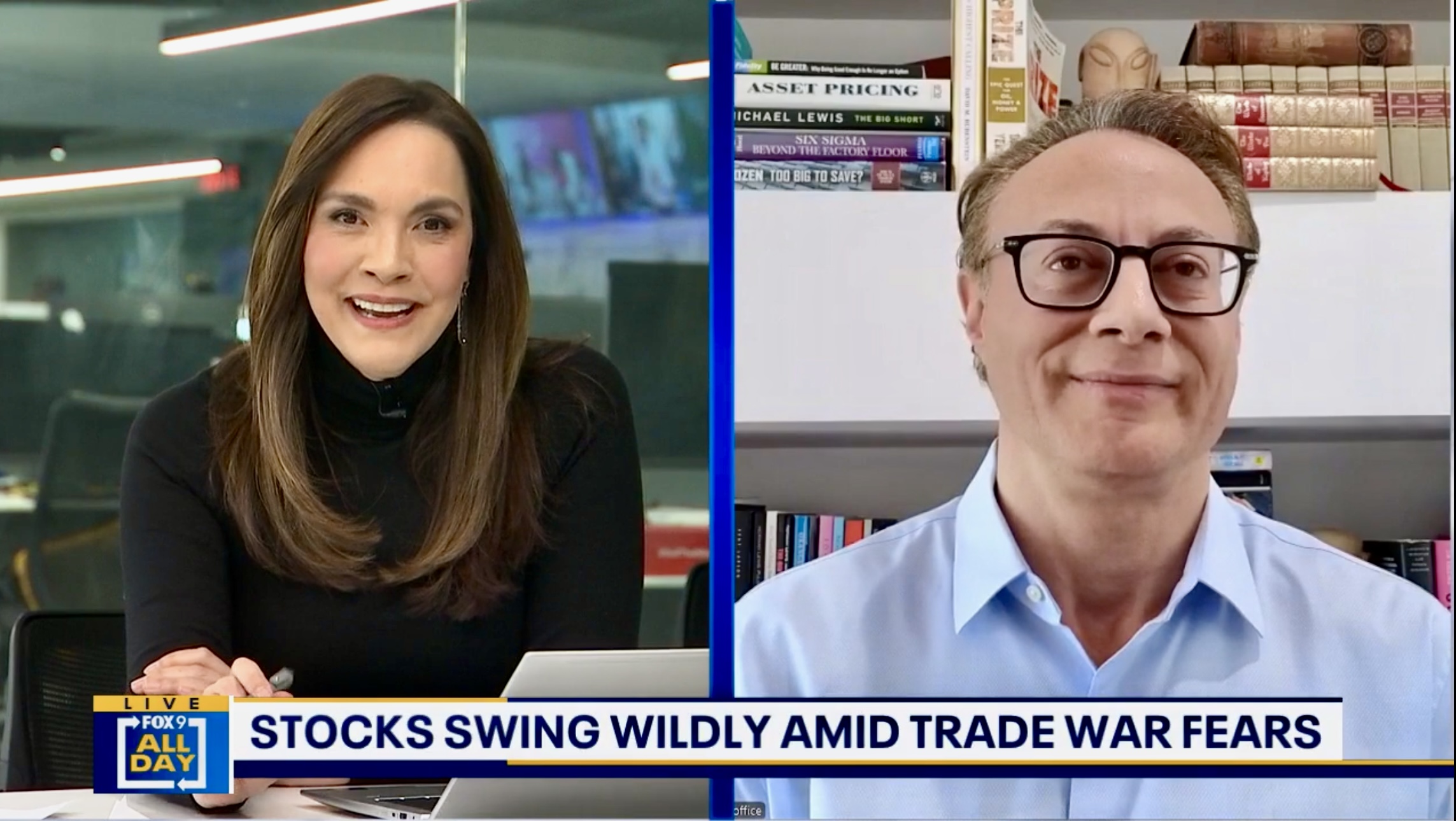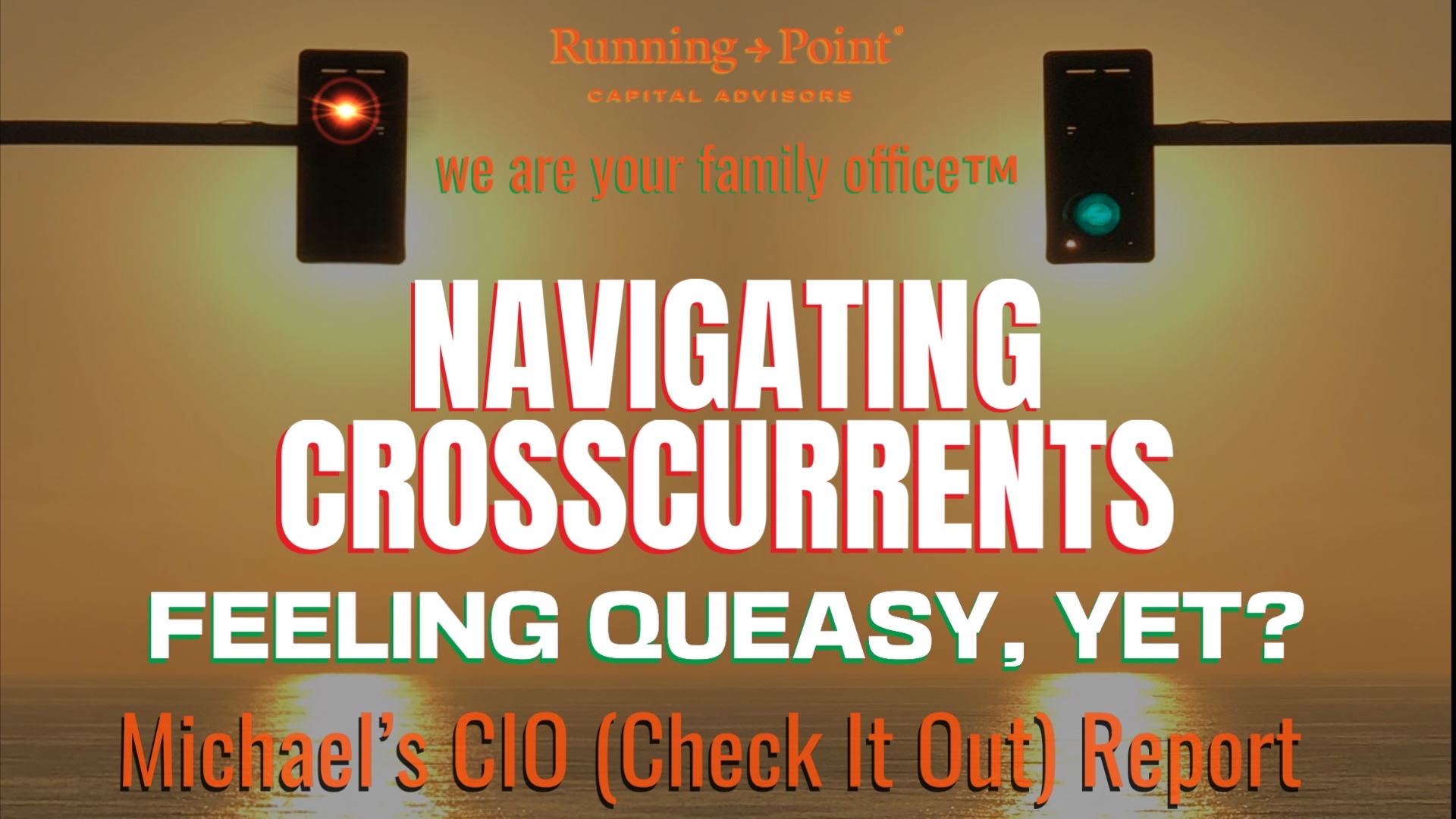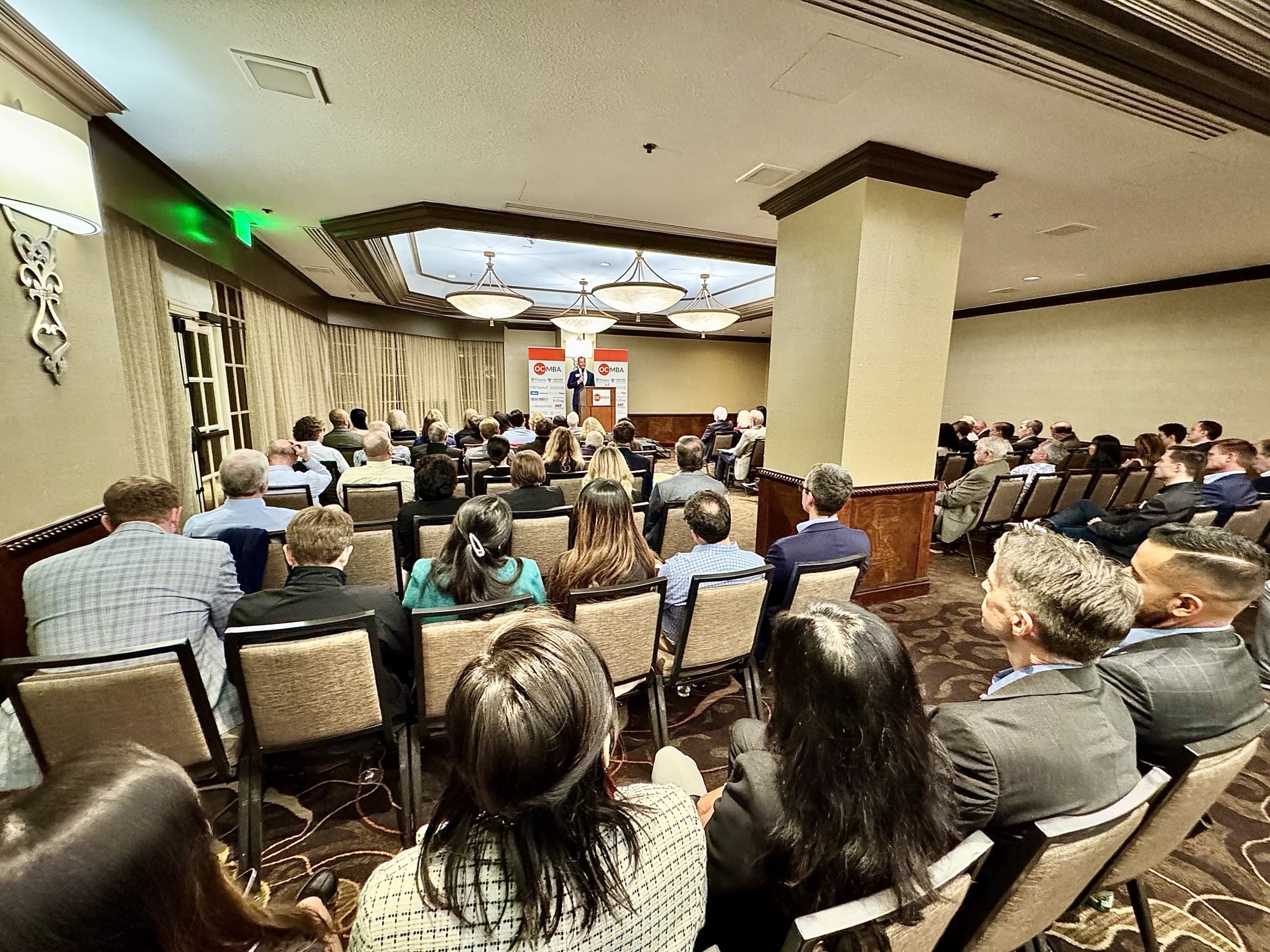2023 will be a Tom and Jerry year, where indicators go in one direction until they don’t
Note: Tom and Jerry is an animated series centered on the comedic back and forth rivalry between a cat named Tom and a mouse named Jerry, and the injuries, recoveries, and mayhem that ensues.
SUMMARY: In 2023, business, social, political, and economic indicators will trend up and down with gusto. It will be a year when events shock and surprise, be it unemployment reports, spending patterns, manufacturing surveys, inflation, layoffs, new legislation, debt ceilings, geopolitical shifts, or revolutions. Like the antics of Tom and Jerry, indicators will seem to trend in one direction until there is an abrupt role reversal. 2023 will be a nauseating back-and-forth bumpy road for all measures of data. Also analogous to Tom and Jerry, the Federal Reserve and the U.S. Executive Branch (as well as Congress) have opposing goals in 2023. The Fed is attempting to slow the economy and increase unemployment to alleviate wage pressures while the Biden Administration attempts the opposite and stimulates to improve household income and avoid recession. There is an investment adage that “the trend is your friend”; this adage still holds true but determining that trend will be confusing. Wall Street usually refers to risk in terms of asset price volatility, i.e., in terms of how much stock, bond, commodity, and other investment valuations jump up and down on an hourly, daily, or monthly basis. However, unless there is a permanent impairment, price volatility is more noise than risk. As long as you have enough cashflow for needs, liabilities, and new opportunities, long-term portfolio risk can be mitigated and you can stick to your financial plan or road map.

LOOKING BACK: Last January, we released our annual outlook, “The Terrible Twos, 2022—Outlook for the Year Ahead.” For better or worse, “The Terrible Twos” was prophetic; here is what we wrote:
- Wobbles: 2022 will be akin to the terrible twos, with short-term political, monetary, and economic wobbles on the path toward long-term progress
- Unwind: No central bank has ever unwound $8.5 trillion of stimulus, and experience with raising interest rates from 0% is limited
- Higher rates: The Fed will likely raise short-term interest rates to normalize policy, but that alone won’t stem inflation — Inflation will dampen when supply chain and labor bottlenecks ease
- StayFlation: Inflation will moderate but remain higher than what we’ve had over the last dozen years— in other words, it is here to stay
- Estates: Tax, estate, and financial plan preparedness are key to moving beyond the investment outlook and having meaningful family office style preparedness and resiliency
- Illiquids: Consider investment structures that take advantage of market uncertainty and inflationary trends
Such was the case. Inflation has moderated from its peak, but remain high, and many private or illiquid investments outperformed the public markets. 2022 was full of wobbles as the Federal Reserve set itself on a path to raise interest rates, curb inflation, and unwind its huge balance sheet by selling bonds.
LOOKING FORWARD: 2023 will be about business, social, economic, and political indicators trending in a certain direction until they aren’t😬. They may go up only to be pounded by a mace, club, or mallet of new data, decapitated in political shifts, shocked by central bank monetary policy, electrocuted by a corporate announcement, or exploded by geopolitics. Or these indicators may drift south, only to be reversed by a sudden change of fortune: new data, fresh political announcements, or renewed hope for easing on monetary policy or geopolitical impasse. Consider it stagnation combined with frequent changes in direction; it will be exasperating. Expect injury, recovery, and mayhem from the cat and mouse nature of volatile data!

Hammerspace can setup a brief gag or turn the tide of a story. In the toon world, hammerspace (no relation to MC Hammer, “can’t touch this”) is an extra-dimension from which objects—hammers, mallets, anvils, animals, cooking appliances, or other gadgets—are magically and instantaneously produced. In 2023, as you listen to unemployment reports, spending patterns, manufacturer surveys, foreign election results, central bank announcements, ransomware attacks, or the anchor people on business channels feign surprise at numbers coming in above or below expectations, think of the hammerspace they are derived from. Moral: Remain focused on your family’s long-term financial plan and on enduring market and investment tenets.
Why now? Isn’t data always volatile? Yes, data reports often jump around month to month or quarter to quarter; in fact, it would be odd if the numbers were especially smooth. However, over the last couple quarters, the economy has treaded inside a tight channel where too much gas or stimulus could drive inflation back up and too much braking or tightening could plunge us into crisis. There is an old investment adage that the trend is your friend; this adage still holds true, but determining that trend will be confusing when there is little room for monetary or fiscal error. Unfortunately, what investors want to happen or think should transpire is often different from what occurs. Inflation, earnings, margins, manufacturing and production indicators, service and entertainment indicators, business spending, consumer spending will surprise positive and negative, trending up in some months and down in others, causing investors and market participants to flippantly second guess themselves. Presto! Surprises will hit the markets like rabbits pulled out of a hat.
Change is changing faster. There will be both good and ugly upside and downside surprises. Socioeconomic indicators will bounce around like a rubber ball. One of the lessons from the 1970’s is not just that inflation went up, but that the volatility of inflation also increased enormously and with it the volatility of interest rates. Massive swings in interest rates and inflation are the enemy of valuation multiples, the enemy of buy-and-hold, and the enemy of the market. That leads to the question of market and investor reactions. Some investors will go all in on these moves and others will give-up their positions.
The Federal Reserve versus the U.S. Executive Branch (and Congress) is also analogous to Tom versus Jerry; they have opposing goals. The government has morphed from a coordinated fight against a pandemic recession (in 2020 and 2021) to an uncoordinated battle against itself in 2022 and 2023. The Fed wants to slow the economy and increase unemployment[i] to reduce inflation, but the elected government wants to stimulate the economy to avoid recession and improve its chance of reelection in 2024. Inflation is high and the administration and legislative branches are supporting it further by distributing hundreds of billions of dollars of stimulus spending, including loan forgiveness, new electric vehicle (EV) incentives, $50 billion to semiconductor manufacturers, and new defense weapon orders. The poor Federal Reserve is fighting all of this by raising interest rates, selling bonds (doing quantitative tightening), and talking tough. There is an adage, “Don’t fight the Fed,” but everyone is fighting the Fed! The Fed remains hawkish: they are combating inflation, investor allocations, and the rest of the government. They are reducing their balance sheet, raising interest rates, and are probably overdoing it because their blunt tools have a long lag effect. The Fed wants to wait for inflation to decline to 2%—which is unlikely—thus the Fed may have to keep interest rates higher for longer[ii] than people expect.
Disparity—in sentiment, war, or insurrection—has been felt in 2022 and may be one of the largest investment performance triggers in 2023. In poll after poll, most money managers and investors are negative in their outlooks, but their investment positioning in stocks does not reflect that pessimism, i.e., they have not reduced their risk exposure to match their sentiment. Thus, if investors truly disparage and throw in the towel, a wave of selling may ensue, but if enthusiasm strikes, purchase momentum might not live up to expectations. Another form of disparity is on display as social and revolutionary agitation has been felt in the U.S., Brazil, Chile, Czech Republic, China, Haiti, Hungary, Iran, Mongolia, Peru, and Sri Lanka and is likely to infect other countries. Will insurgency spread to Russia as a disastrous war against Ukraine continues? Doubtful, but possible. What we stated last year still remains startlingly true, “almost every government around the globe is on notice as citizens have endured repetitive shutdowns, cumbersome yo-yo regulations, and changing rules that lack logic.” Why is this so important? With most of our Tom and Jerry analogy, the up-and-down vagaries of data create the back-and-forth responses from market participants (individuals, professional investors, algorithms, artificial intelligence (AI), and super computers); i.e., the data is a catalyst for a response. However, with disparity, the opposite is true; opinions, attitudes, and responses not only lead the data, they create the data—the emotions and insurgency come first and therefore the actual outcomes are much more unpredictable.
Prepare, prepare, prepare! The irony is that this is the most well announced and highly anticipated recession in memory. The thing about such a well telegraphed possibility of recession is that everyone (corporations and governments) has had time to prepare for it and if anything has been learned over the last three years of pandemic turbulence, it is flexibility. Many people want it sooner rather than later because they figure a recession would cause the Federal Reserve to lower interest rates and re-stimulate the economy; i.e., bad news would quickly turn into good news. The fallacy is that if inflation remains elevated the Fed probably won’t ease because Chair Jerome Powell is following ex-Chairman Volker’s playbook[iii] (which in my opinion was faulty and remains unproven[iv]) of raising interest rates to squash inflation.We are most concerned about the possibility of a reduction in bank lending that leads to a freeze in credit markets. Better to have interest rates at 8% and financial firms lending than rates at 2% and no one lending. Capitalism does not operate well without credit. A lending freeze could drive a self-reinforcing downturn in macro indicators and markets. Connecting the dots here will not be trivial.
That’s not all folks. Humor aside, we are quite hopeful that the rough roads of 2023 will be a terrific set up for well-timed and promising investment opportunities. Not everything is rosy, but not everything is doom and gloom.
- A U.S. recession is not unavoidable. Despite or maybe because most analysts are calling for a mild to severe recession, an economic downturn is not inevitable. The economy may slow, but it might not go negative because government spending remains stimulative, consumers still have over $1 trillion of pent-up pandemic savings they can spend, wages are rising, companies remain profitable with historically wide margins, and the pragmatism with which the US Government settled a potentially economically destructive rail strike dispute in December provides hope that cool heads can prevail
- The U.S. jobs market remains incredibly strong. A strong labor market means the Fed need not reduce interest rates. At full employment workers have solid bargaining power to secure higher benefits and wages that add to costs and create more buying power in the economy. It also incentivizes businesses to implement more labor-saving machinery[v] and productivity improving technology. In the short to medium-term, labor demand and the purchase of more technology will support inflationary pressures
- Inflation is intractable. Inflation will look like it is declining until other indicators show it strengthening. We maintain our stayflation call that we’ve had since 2021: that inflation will remain above[vi] historical norms, closer to the 3% to 4% range. The era of 2% or less inflation in the U.S. is over and we are unlikely to return to a super low-rate environment for a while
- Home prices won’t collapse. Housing is underbuilt, there are more Millennials than Baby Boomers, and inflation is pushing up replacement expenses[vii]
- Corporate revenue and costs will increase. Earnings will suffer, but there remain many good companies earning solid returns on equity (ROE)
- A default cycle is coming. Corporate defaults will probably increase even as other companies boast record revenues
- China will experience a solid yet bumpy year of growth. China, already near a multidecade low growth rate, will unlock its economy in staggard steps as the end of zero-COVID policy opens cities, but actual COVID[viii] cases will cost lives and workplace productivity. China wants to shift its populace from middle-income to high-income; to do that, they need to develop domestic consumption and progress from low-cost production to higher cost services. This may mean that their “expansion” might not be as resource or commodity intensive as in the past
- Asset prices are lower, and that aids new investment. After a tumultuous 2022, asset prices are relatively lower than they were a year ago. If you are a long-term acquirer of investments and assets, you want to buy at lower prices and 2022 has provided that setup across—public and private—equity and debt
- The U.S. dollar will preserve as the world’s main reserve currency. Currencies are all relative to each other. Even if we enter recession, the U.S.’s long-term prospects will remain strong relative to other nations that may face an even worse situation
More than a hundred fifty private deals passed into our funnel last year and we expect that number to be higher in 2023. Over the next 18 months, we should have the ability to invest in high-quality assets at attractive entry multiples. Dislocation vintages, those private asset vintages created in the aftermath of volatility or recessions historically have been amongst the best performers because uncertainty creates opportunities to deploy capital and make new investments at attractive valuations. Thus, we like uncertainty and will actively seek attractive investment structures and opportunities—in private credit, healthcare real estate, well priced secondary private equity, female led venture capital that is valuation sensitive, hedge funds that are not trend dependent, and other adaptable strategies—that can react quickly to and take advantage of valuation downdrafts, market turbulence, panicked sellers, or distress.
Additionally, as appropriate, we will seek to effectively increase portfolio income across equity and debt investments to increase conservative positioning, improve cash flow for liabilities, and augment our store of patient capital to use for fresh purchases. With higher interest rates and more persistent inflation, there’s going to be an emphasis on high quality balance sheets and companies that can produce and grow free cash flow. Growing cash flow and profits (as well as having huge piles of serviceable debt) are amongst the best inflation hedges. When we get through this cycle, we are not immediately returning to economic environment of the last dozen years; people may think we are, because that’s what they know, but that’s the influence of recency bias.
Regardless of what happens in this cat and mouse game of data surprises, reactions, and emotions over the next year or decade, tax, estate, insurance, accounting, business, and financial plan preparedness are key to moving beyond a single year’s investment outlook and having meaningful family office style preparedness and resiliency. What strategies make the most sense for your family? The short answer: You start with a financial plan, proper estate and trust planning, and tax efficiency. Is private placement life insurance with tax-free growth appropriate for you? It depends! Every family has different financial circumstances and different family values. At Running Point, we start by listening to you to gain a clear understanding of your values, your priorities, and your objectives.
Make it a great new year,
Michael Ashley Schulman, CFA
Partner and Chief Investment Officer
ENDNOTES
[i] The Fed endeavors to increase unemployment by around 1% from the low point to stem wage pressure and decrease average wage growth. However, the Fed cannot operate with such precision and once unemployment rises it can quickly blow through that 1% marker. When unemployment goes up a little it often goes up a lot. Historically, when the unemployment rate increases 0.35% on a three-month moving average, that often marks the first month of a recession, and once that occurs, it usually increases approximately 2.5%.
[ii] In the mid-1970s the Fed made the mistake of celebrating victory too soon and cutting rates, only to see another bout of inflation. Expect this Fed to take that lesson to heart; i.e., do not expect a swift cut in the Fed funds rate (which is at 4.25% to 4.5%).
[iii] “I feel that today’s move is an admission from the Federal Reserve that it was too loose and generous with its monetary policy in 2021 and are trying to reverse that quickly,” said Michael Ashley Schulman, founding partner and Chief Investment Officer at Running Point Capital. “The fact that the Fed is putting another 75-basis-point hike on the table for its July meeting is hinting to the world that Chair Powell is willing to follow Paul Volcker’s inflation fighting playbook from the 1980’s that pushed America into recession. But then, as now, whether higher interest rates will break inflation or lower energy prices will break inflation is really the debate.” Insurance Newsnet article by Doug Bailey, June 15, 2022.
[iv] I believe that Chair Powell is following Volker’s playbook of pushing the US. into recession to stop inflation😟. Not the best strategy. And history remains undecided whether Volker or increased oil supplies stemmed inflation🤷🏽 [see i-Bump].
[v] Since the pandemic, we are in a world of constrained aggregate supply. Price shocks now are not self-equilibrating. The supply shocks coming down the road should equate to more investment (and more supply pressure); e.g., when you think about them, they ought to invite a lot more investment, not less. For example, when you move away from fossil fuels to renewables, that will take a lot of investment which will increase aggregate demand. To battle climate change, we will have to do a lot of things different. When you consider the demographics, companies can’t get the labor they need, so they will raise investment to replace high priced labor with real capital.
[vi] As the inflation base effect becomes favorable due to a drop in goods prices, US inflation will decline, but as in the 1970’s, structural factors could prompt a renewed inflationary wave especially if demand for labor, productivity tech, and labor replacement technology (robotics) remains strong.
Labor supply will remain an issue. Since the pandemic began, the dual crises of COVID and opioid overdoses have killed more than 1.3 million people in the U.S. and resulted in an even greater increase in people with disabilities; some estimates range from 1.2 to 4 million people.
[vii] See our original Game of Homes call from November 8, 2021 for a fuller rationale to support home prices.
[viii] China is amidst its first national COVID wave, will probably experience a second COVID wave after Lunar New Year celebrations, and then a third wave around mid-2023 if it follows the patterns seen in other countries.
Disclosure: The opinions expressed are those of Running Point Capital Advisors, LLC (Running Point) and are subject to change without notice. The opinions referenced are as of the date of publication, may be modified due to changes in the market or economic conditions, and may not necessarily come to pass. Past performance is not indicative of future results. Forward-looking statements cannot be guaranteed. Running Point is an investment adviser registered with the U.S. Securities and Exchange Commission. Registration does not imply a certain level of skill or training. More information about Running Point’s investment advisory services and fees can be found in its Form ADV Part 2, which is available upon request. RP-23-07


